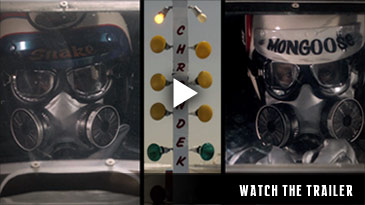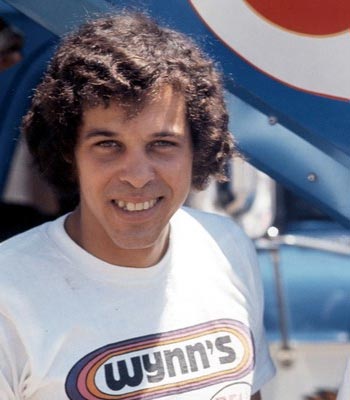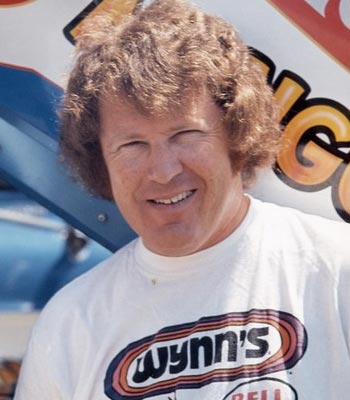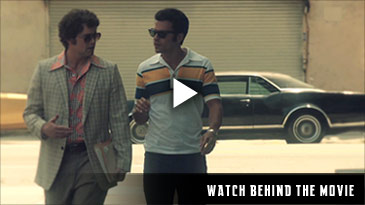
Synopsis

In nature, the snake and mongoose are the deadliest of enemies—genetically encoded to eternally fight to the death without mercy. Beginning in the 1960's, the nature of that dynamic was strategically and expertly applied to the historic rivalry between Don Prudhomme and Tom McEwen in the most unlikely of venues—a "minor" sport struggling for attention on dusty drag-racing strips at tracks across the country. There, Prudhomme, the Snake, and McEwen, the Mongoo$e, did, in fact, compete aggressively for dominance in the nascent sport of drag racing. Racing aficionados probably know that much of the story by now.
But, what if that rivalry spawned something more than victories and defeats? What if it created a unique and unlikely friendship out of the smoke of battle? What if Snake and Mongoo$e were quietly the closest of friends even as their rivalry intensified? What if they shared the joy and pain of life when they were not busy competing? What if their mutual respect, racing nerve, thirst for fame and compensation, and their desire to advance their thrilling, but extremely dangerous, sport brought them together as something more than mere rivals? What if a perfect storm of conditions transformed their competition into something greater—a blood kinship that enabled them to team up in order to revolutionize an entire industry?
There is no need to wonder "what if"—that's what really happened while the two real-life Southern California drag racing legends were setting tracks on fire during those years. But, until now, few people outside of the racing community knew the true and full story of the Snake and the Mongoo$e. That is about to change with the long overdue release of the independent film, "Snake and Mongoo$e," from British director Wayne Holloway and production partners Entertainment Universe, Rhino Films, and the National Hot Rod Association (NHRA). The film documents the full texture of the real-life relationship in all its colorful permutations—the rivalry, the races, the fights, the victories, their partnership and business success, and their tender support for each.
Before that tragedy struck, they managed to put drag racing on the map for the first time, and changed motor sports forever, starting with the 1970 sponsorship agreement with Mattel's Hot Wheels toys that soon gave birth to the corporate sponsorship and licensing model that continues to dominate motor sports, and many other sports, to this day. But while that was going on, the pain of a failed marriage, the tragic illness of a child, and the loneliness of the road weighed heavily on both men and their families. "Snake & Mongoo$e" probes these many layers of their enduring relationship on a big-stage platform for the first time.
The film also features archival National Hot Rod Association (NHRA) footage and consulting and producing expertise from the real-life Prudhomme and McEwen. It's based on the journalistic work of writer Alan Paradise, who documented the rivalry for years before taking on screenwriting chores.
The movie stunningly chronicles a vintage slice of American culture as it came to life, while simultaneously documenting in compelling and dramatic terms one of the deepest and longest-lasting relationships in the history of sports.
At its core, "Snake & Mongoo$e" is a true and passionate story about the meaning of enduring friendship.
The Greatest Rivals in Drag Racing History

Don "The Snake" Prudhomme
Ask even the most casual of motor sports fans who the biggest name in drag racing is and you are almost always sure to hear one name – Don "The Snake" Prudhomme. A true legend of the sport, Prudhomme, 69, concluded his 47th year in drag racing in 2009, his 15th season as an owner after logging 32 seasons behind the wheel as one of the sport's elite drivers.
Snake's remarkable driving career began in 1962 with his first Top Fuel victory at "Smokers March Meet" in Bakersfield, Calif., before ending with 49 NHRA career victories – the sixth most in NHRA history – following his farewell "Final Strike Tour" in 1994. For his career, Prudhomme reached the finals 68 times, posting a remarkable 35 wins in 45 Funny Car finals (.777 win percentage) and 14 wins in 23 Top Fuel finals rounds (.609 win percentage). Overall, he won 389 of 589 rounds of competition for a .660 winning percentage. Along the way, Prudhomme reached many important milestones and broke several barriers in the sport. He became the first driver to win four consecutive NHRA series titles, won the prestigious U.S. Nationals seven times, was the first Funny Car driver to break the 250-mph mark (250.00 mph), was the first to post an elapsed time under 5.20 seconds (5.193), became the first driver to win seven of eight national events in one season (1976), was the first NHRA Winston World Champion (1975), and became the first driver to win the U.S. Nationals and Winternationals in the same season (1965). At age 51, he became the third Top Fuel driver to pass the 300-mph mark (301.60) in 1993./
Off the track, Prudhomme gained notoriety in the early 1970s when Mattel introduced the "Mongoo$e (Tom McEwen) and Snake" Hot Wheels car sets, helping to introduce the sport of drag racing to a larger, more mainstream audience.
Prudhomme did not stop re-writing the NHRA record books despite leaving his role as a driver to become a multi-car team owner. Wins by Larry Dixon (Top Fuel) and Ron Capps (Funny Car) at the 1998 Winternationals in Pomona, Calif., saw Snake become only the fifth owner in history to have cars in two different categories take home event titles at the season-opening event./p> 
The 2000 season saw many highlights for Prudhomme. As a team owner, both drivers Larry Dixon and Ron Capps finished in the top three in the championship points race while Prudhomme was honored for his accomplishments as a driver with his induction into the International Motorsports Hall of Fame in Talladega, Ala. with such other racing heroes as A.J. Foyt, Mario Andretti and Aryton Senna.
Prudhomme inched ever closer to his milestone 100th victory in 2004 as Dixon earned two victories moving the legendary driver/owner within two victories of the century mark. Dixon's 35th career win in August equaled drag racing icon "Big Daddy" Don Garlits for third on the all-time Top Fuel wins list.
Prudhomme also saw Johnson post career-best performance marks in his blue Skoal Racing Chevy flopper at the season-finale in Pomona (Calif.).
The 2009 NHRA Full Throttle campaign saw the debut of rookie driver Spencer Massey taking over the role as pilot of the U.S. Smokeless Racing dragster for Don Prudhomme Racing. Massey, the 2008 IHRA Top Fuel Champion, reached five final rounds while collecting his first career NHRA Top Fuel win at Joliet, IL and his second in Las Vegas (wins No. 111 and No. 112 for Prudhomme). Massey went on to win the 2009 NHRA Rookie of the Year award. Prudhomme also teamed up with Carroll Shelby as Shelby Autos announced the limited production of the Shelby Super Snake Prudhomme Edition GT 500. Motorbooks International also published Tom Madigan's book – "Mongoo$e vs. Snake – How a Rivalry Changed Drag Racing Forever."

Tom "The Mongoo$e" McEwen
Tom McEwen is listed as number 16 of the 50 most significant drivers of NHRA's first 50 years. He received the nickname "the Mongoo$e" in 1964 from engine builder Ed Donovan. It was largely originally used as a device to entice Don "the Snake" Prudhomme into a high-exposure match race. McEwen won five NHRA national events, three AHRA World Championships, and was entered into three hall of fames during his 45-plus-year career, but McEwen's gift for gab and promotional ability made him one of the sport's most influential and controversial figures.
When Tom came up with the Hot Wheels deal using the Snake and Mongoo$e characters, it shook the world of drag racing big time. He produced a sponsorship package that allowed him and Prudhomme to buy the best equipment, pay expenses, make money and sell their image all over the United States. I hate to admit it but McEwen and Prudhomme showed us the way to the future. They were a lot smarter than most of us who didn't see past the end of the quarter-mile."
McEwen gained his early experience in a variety of rides, beginning in 1953 with a '53 Oldsmobile at Santa Ana Dragstrip in Irvine, California. He then went on to race a '54 Olds at Lions Dragstrip in Long Beach, California.
He went from the stock ranks to gas coupes, altereds, and eventually dragsters and funny cars. Among the cars he drove were the Stone-Woods-Cook '50 Olds fastback, the Bader & Ferrara Cadillac-powered Crosseyed Crosley, Art Chrisman's Hustler II, the Bud Rasner and Gary Slusser Fiat coupe, Dick Rea's Chrysler-powered blown gas dragster, and Gene Adams' Albertson Olds.
McEwen continued his relationship with Adams for several years. In 1962, he drove Adams' Shark, which was one of the first dragsters to use a streamlined body with an enclosed parachute pack. This would turn out to be one of McEwen's best known rides, beating Don Garlits.
In 1963, McEwen achieved his greatest success at the time when he posted a runner-up finish against Art Malone at the Bakersfield March Meet in California in the Broussard- Garrison-Purcell-Davis car. He also drove Donovan's Donovan Engineering Special dragster, and it was in this car he first raced Prudhomme.
McEwen won his race against Prudhomme at Lions Dragstrip on September 12, 1964. He overcame Prudhomme's bright-orange edition of the famed Greer-Black-Prudhomme car in two straight sets, inspiring what may be the most famous match-race pairing in the history of drag racing. After this Ed Donovan nicknamed the pair the "Mongoo$e" and the "Snake."
Later in 1964, McEwen drove Lou Baney's Yeakel Plymouth-sponsored dragster to victory at the 32-car UDRA meet at Fontana Raceway in Fontana, California. He also took Top Fuel titles at Lions Dragstrip and Pomona Raceway.
Because their first get-together had received so much attention, two more races between McEwen and Prudhomme were staged at Lions Dragstrip in 1965. McEwen drove the Yeakel Plymouth dragster past Prudhomme and his new ride, the Leong-owned Hawaiian, two rounds to one in the first, then lost in two straight sets in the second.
Because McEwen confined his racing to the West Coast, he and the touring Prudhomme raced each other only once in 1966, at the Winternationals, site of their first national event meeting. There, Prudhomme in the B&M Torkmaster Special took the win, with a 7.59 e.t. to McEwen's 7.69. They would not meet again for the rest of the decade.
McEwen won the 1966 Hot Rod Magazine Championships at Riverside Raceway and then went on to win the 1968 Stardust National Open in Las Vegas. He also recorded the lowest ever elapsed time to date with a blistering 6.64 at the Orange County PDA Meet in 1968.
McEwen also continued to build on his reputation as a colorful promoter. The Plymouth Hemi Cuda he unveiled in 1965 was featured in every major car magazine. He convinced the Southern California Plymouth Dealers Association to support him and displayed the car all over the West Coast.
In 1967, McEwen took the same approach with one of drag racing's great one-shot wonders: Ford Motor Company's Super Mustang. When it made its highly anticipated debut at the Winternationals, it generated significant publicity.
McEwen's strong promotional talent and Prudhomme's success on the racetrack eventually led to the formation of a national touring team sponsored by Mattel and, in mid-1969, McEwen and Prudhomme corporately became Wildlife Racing.
The Mattel deal ran from 1970 through 1972, and in 1973, Wildlife Racing secured Carefree sugarless gum as a sponsor. McEwen and Prudhomme dissolved their corporation at the end of the 1973 season.
In 1972, McEwen won his first major event when he dominated the Top Fuel field at the Bakersfield March Meet. A year later, he scored his first NHRA national event victory by topping the quickest funny car field in history at the SuperNationals at Ontario Motor Speedway, which was the NHRA's first $20,000 prize.
McEwen went on to win four more national events, including his dramatic U.S. Nationals funny car victory over Prudhomme in 1978, following the death just a few days earlier of his son, Jamie from Leukemia. He also won the prestigious Big Bud Shootout in 1984 and won Top Fuel at the 1991 Summernationals.
Tom McEwen officially retired as a driver in 1992, but has remained active in various areas of the racing field.
Behind The Movie

Like any good Hollywood drama, the story elements that make up "Snake & Mongoo$e" are almost too good to be true, and yet, they are true. While the over-arching scope of their rivalry was known in racing circles, even there, the context and depth and motivations behind that story were missing. Journalist Alan Paradise was among the first to realize the cinematic possibilities in the story when he was working on a documentary about the Snake and Mongoo$e after years covering their world as an automotive journalist.
Paradise knew that most of the public remained keenly unaware of what lay beneath the surface of the legendary Snake/Mongoo$e rivalry. And he was savvy enough to realize that it was a story possessing all the essentials that successful movies require—deep and compelling characters, rich drama and comedy mixed together, tragedy, triumph, and redemption.
"Many in this generation know who Don Prudhomme and Tom McEwen were as the Snake and Mongoo$e, and we know them from the Hot Wheels cars, and probably many of us had those toy cars and played with them as children," Paradise relates. "But what we probably didn't know is the back story behind all that. The more I kept digging into this, the more intriguing the story got, and the deeper the story got. There was so much texture and color behind it, so I said to myself, this is more than a magazine article, more than a book. There is real cinematic value here."
Once producers Robin Broidy and Stephen Nemeth put the project together and brought director Wayne Holloway's unique cinematic eye to the project, making the movie was another issue entirely. To properly execute their mission, filmmakers needed the real-life Don Prudhomme and Tom McEwen on board. And both men did bless the production, joined up as executive producers, and more importantly, served as uniquely open and helpful on-set consultants throughout production.
For both of them, however, principal photography on "Snake & Mongoo$e" over 24 days in May and June of 2012 must have seemed a bit like they had entered a time warp.
Not only did they encounter two actors in Jesse Williams and Richard Blake who looked and dressed and talked exactly like they did about four decades earlier, but they also saw both their own restored dragsters and funny cars from that era, and exact replicas, back out on a familiar track—the Famoso Raceway in Bakersfield, California, where most of the movie's racing sequences were shot, and where both Prudhomme and McEwen made names for themselves early in their careers.
There, over the course of the production, Famoso was dressed and later in post- production, digitally altered and extended to double for a series of other vintage tracks from the era of the Snake and Mongoo$e. Holloway and cinematographer John Bailey, using state of the art Arri Alexa digital camera systems, had the privilege of shooting a variety of sequences involving Prudhomme's and McEwen's actual, restored cars in some cases, and exact duplicates in others. Among the vehicles the production was able to utilize were Prudhomme's 1970 Yellow Cuda Hot Wheels Funny Car and the iconic yellow hauler that carried it across the country, a spot-on reproduction of McEwen's famous 1970 Red Duster Hot Wheels Funny Car and it's iconic red hauler.
Also taking part in the production were Prudhomme's actual Plymouth Arrow Funny Car from the mid-1970's, once again sporting its US Army sponsorship decals; McEwen's English Leather 1978 Corvette; and other vintage cars. Amazingly the production was also granted access to two very early and important dragsters in the careers of Snake and Mongoo$e. The first was called the Greer Black Prudhomme, which was restored and owned by mega car collector and Salt Flats racer, Bruce Meyer, as well as the Baney, Yeakel Plymouth Special, restored and owned by Lou Baney's son, Frank Baney. Of course, the welfare of the vintage cars, not to mention strict safety requirements, prohibited the staging of practical, all-out, 200mph-plus drag races along the lines of the fierce battles that Prudhomme and McEwen once routinely engaged in. And so, the production made extensive use of vintage footage from the National Hot Rod Association (NHRA), which fully cooperated with the production, to bring audiences inside many of the actual competitions in which the two rivals participated. Filmmakers also secured original 16mm film footage from the real-life Snake's personal vaults as well as from other film collectors around the country.
